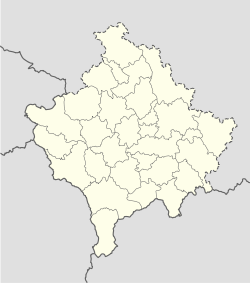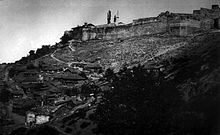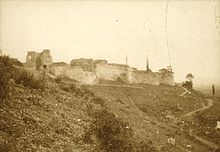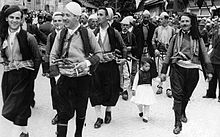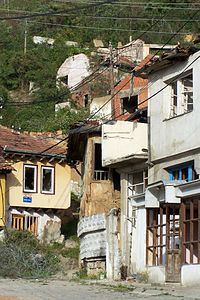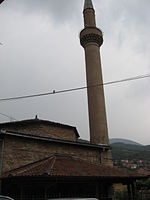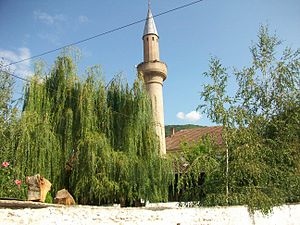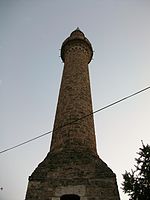- Prizren
-
Prizren — Municipality and city — Prizren
Prizren / Prizreni / ПризренTop row: Prizren
Second row: League of Prizren, Old Stone Bridge, Prizren
Third row: Our Lady of Ljeviš, Minaret of Arasta Mosque, Sinan Pasha Mosque
Forth row: Namazgâh, Municipality Building
Bottom row: Prizrenska BistricaLocation in Kosovo Coordinates: 42°13′N 20°44′E / 42.217°N 20.733°ECoordinates: 42°13′N 20°44′E / 42.217°N 20.733°E Country Kosovo[a] District District of Prizren Elevation 400 m (1,312 ft) Population (2011) – Total 178,112 (municipality) 121,000 city – Density 284.2/km2 (736.1/sq mi) Time zone CET (UTC+1) – Summer (DST) CEST (UTC+2) Area code(s) +381 29 Car plates 04 Website Municipality of Prizren Prizren (Albanian: Prizren or Prizreni; Serbian: Призрен, Prizren, pronounced [prîzrɛn]; Turkish: Prizren, Pürzeyn, Perzerrin) is a historical city located in southern Kosovo[a]. It is the administrative center of the eponymous municipality and district.
The city has a population of around 131,247 (2010 estimate),[1] mostly Albanians. The municipality has an estimated population of about 170,000 inhabitants, comprising both the town itself and its 76 villages.[2]
Prizren is located on the slopes of the Šar Mountains (Albanian: Malet e Sharrit) in the southern part of Kosovo, at 42°14′N 20°44′E / 42.23°N 20.74°E.[3] The municipality has a border with Albania and the Republic of Macedonia.
Contents
History
For Timeline of the History of Kosovo including many places in Prizren, see Timeline of Kosovo history.Ancient
Main article: TherandaThe Roman[4] town of Theranda in Ptolemy's Geography is mentioned in the 2nd century A.D.. In the 5th century A.D. it is mentioned as being restored in Dardania with the name of Petrizên by Procopius of Caesarea in De aedificiis (Book IV, Chapter 4).[5] Sometimes it is mentioned even in relation to the Justiniana Prima.[citation needed]
It is thought that its modern name comes from old Serbian Призрѣнь, from при-зрѣти, indicating fortress which could be seen from afar[6] (compare with Czech Přízřenice or mount Ozren).
Medieval
The Serbs, one of the Slavic tribes that settled the Balkans in the 6th-7th centuries AD, acquired the spiritual and cultural orientation they have retained to this day when they accepted Byzantine Orthodox Christianity in the 9th century. They remained within Constantinople’s cultural sphere of influence, while however becoming more independent, forging autonomous kingdoms based on the opportunities that this Christian orientation provided for the development of a coherent civilization and state.
While there were some predecessors, the first major Serbian power arose in 1166, when the Nemanjic dynasty emerged, headed first by Tihomir and then by his brother Stefan. The Serbian Nemanjic dynasty would base the Serbian empire in Kosovo and Metohija, making Kosovo the political, cultural, and religious center of the Serbia. Metohija, which refers more specifically to western Kosovo, is a Byzantine Greek word indicating possessions held by the Orthodox Church. The Nemanjic dynasty would endure until 1371 when it would end due to the invasion of the Ottoman Turks and defeat at the 1371 battle of Marica.
As the Serbian empire sought an outlet to the Adriatic coast, the administrative and religious center of the empire shifted to Shkodër, Prizren, and Decani.
Ottoman period
Further information: Kosovo Province, Ottoman Empire#SubdivisionsPrizren Vilayet
Main article: Prizren VilayetIn 1455 Ottoman army had conquered Prizren. Prizren was the capitol of the Sanjak of Prizren, and under new administrative organization of Ottoman Empire it became capitol of the Vilayet.[7] This included the city of Tetova.[8] That time this open mosque had built. It is the first work of Ottoman architecture in Prizren.[citation needed] In recent years, has undergone serious repair and renovation.[citation needed]. Marino Bizzi, the Archbishop of Bar (Antivari), in his 1610 report stated that Prizren had 8.600 large houses and that it was irrigated by many sources of flowing water, like fountains.[9] He recorded that the population of Prizren spoke the Dalmatian language, although some part of the Sanjak of Prizren penetrates into Albania, which population speak its own language.[10] Later it became a part of the Ottoman province of Rumelia. It was a prosperous trade city, benefiting from its position on the north-south and east-west trade routes across the Empire. Prizren became one of the larger cities of the Ottomans' Kosovo Province (vilayet). Prizren was the cultural and intellectual centre of Ottoman Kosovo. It was dominated by its Muslim population, who composed over 70% of its population in 1857. The city became the biggest Albanian cultural centre and the coordination political and cultural capital of the Kosovar Albanians. In 1871, a long Serbian seminary was opened in Prizren, discussing the possible joining of the old Serbia's territories with the Principality of Serbia.
Kosovo Vilayet
Prizren was an important part of Kosovo Vilayet between 1877–1912.
League of Prizren
During the late 19th century the city became a focal point for Albanian nationalism and saw the creation in 1878 of the League of Prizren, a movement formed to seek the national unification and liberation of Albanians within the Ottoman Empire.
Young Turk Revolution
The Young Turk Revolution was a step in the dissolving of the Ottoman empire that led to the Balkan Wars. The Third Army (Ottoman Empire) had a division in Prizren, at the time called Pirzerin, the 30th Pirzerin Reserve Infantry Division (Otuzuncu Pirzerin Redif Fırkası).
Balkan wars
The Prizren attachment was part of the İpek Detachment in the Order of Battle, October 19, 1912 in the First Balkan War.
During the First Balkan War the city was seized by the Serbian army and incorporated into the Kingdom of Serbia[citation needed]. After the Serbian army achieved control over the city of Prizren, it imposed a repressive measures against the civilian population. Serbian detachments breaking into the houses, plundering, making violence and killing indiscriminately.[11] Around 400 people were "eradicated" in the first days of the Serbian military administration.[11] Bodies were lying everywhere on the streets. According to witnesses, these days around Prizren were about 1,500 corpses of Albanians.[12]
Foreign reporters were not allowed to go to Prizren.[12] The British traveler Edith Durham attempted to visit it shortly afterward but was barred by the authorities, as were most other foreigners, for the Montenegrin forces temporarily closed the city before full control was restored. A few visitors did make it through—including Leon Trotsky, then working as a war correspondent—and reports eventually emerged of widespread killings of Albanians. One of the most vivid accounts was provided by the Catholic Archbishop of Skopje, who wrote an impassioned dispatch to the Pope on the dire conditions in Prizren immediately after its capture by Serbia:
- "The town resembles the kingdom of death. They knock at the doors of Albanian homes, take the men out and shoot them right away, simply because they are Albanians."[12]
It is estimated that 5.000 Albanians were massacred in the area of Prizren.[12]
Yugoslav period
With the invasion of the Kingdom of Serbia by Austro-Hungarian forces in 1915 during the First World War, the city was occupied by the Central Powers. The Serbian Army pushed the Central Powers out of the city in October 1918. By the end of 1918, the Kingdom of Serbs, Croats and Slovenes was formed—with Prizren a part of its historical territorial entity of Serbia. The Kingdom was renamed in 1929 to the Kingdom of Yugoslavia and Prizren became a part of its Banate of Vardar.
German video of Prizren 1934
Second League of Prizren
Main article: Second League of PrizrenThe Axis Italian forces conquered the city in 1941 during World War II; it was annexed to the Italian puppet state of Albania. In 1943 with the help of the German Wehrmacht Bedri Pejani created the Second League of Prizren.[13]
Democratic Federal Yugoslavia
The Communists of Yugoslavia liberated it by 1944. It was formulated as a part of Kosovo and Metohija, under Democratic Serbia as a part of the Democratic Federal Yugoslavia. The Constitution defined the Autonomous Region of Kosovo and Metohija within the People's Republic of Serbia, a constituent state of the Federal People's Republic of Yugoslavia. In 9–10 July 1945 the Regional Assembly of Kosovo and Metohija held in Prizren adopted the decision of abolishing the region's autonomy and direct integration into Serbia.
The Province was renamed to Socialist Autonomous Province of Kosovo in 1974, remaining part of the Socialist Republic of Serbia, but having attributions similar to a Socialist Republic within the Socialist Federal Republic of Yugoslavia. The former status was restored in 1989, and officially in 1990.
For many years after the restoration of Serbian rule, Prizren and the region of Dečani to the west remained centres of Albanian nationalism. In 1956 the Yugoslav secret police put on trial in Prizren nine Kosovo Albanians accused of having been infiltrated into the country by the (hostile) Communist Albanian regime of Enver Hoxha. The "Prizren trial" became something of a cause célèbre after it emerged that a number of leading Yugoslav Communists had allegedly had contacts with the accused. The nine accused were all convicted and sentenced to long prison sentences, but were released and declared innocent in 1968 with Kosovo's assembly declaring that the trial had been "staged and mendacious."
Kosovo War
The town of Prizren did not suffer much during the Kosovo War but its surrounding municipality was badly affected 1998-1999. Before the war, the Organization for Security and Co-operation in Europe estimated that the municipality's population was about 78% Kosovo Albanian, 5% Serb and 17% from other national communities. During the war most of the Albanian population were either forced or intimidated into leaving the town. Tusus Neighborhood suffered the most. Some twenty-seven to thirty-four people were killed and over one hundred houses were burned.[14]
At the end of the war in June 1999, most of the Albanian population returned to Prizren. Serbian and Roma minorities fled, with the OSCE estimating that 97% of Serbs and 60% of Romas had left Prizren by October. The community is now predominantly ethnically Albanian, but other minorities such as Turkish, Ashkali (a minority declaring itself as Albanian Roma) and Bosniak (including Torbesh community) live there as well, be that in the city itself, or in villages around. Such locations include Sredska, Mamuša, the region of Gora, etc. [1]
The war and its aftermath caused only a moderate amount of damage to the city compared to other cities in Kosovo.[15] Serbian forces destroyed an important Albanian cultural monument in Prizren, the League of Prizren building[16][17] On March 17, 2004, during the Unrest in Kosovo, all Serb cultural monuments in Prizren were damaged, burned or destroyed, such as old Orthodox Serb churches:
- Our Lady of Ljeviš from 1307 (UNESCO World Heritage Site)[18]
- the Church of Holy Salvation[18]
- Church of St. George[18] (the city's largest church)
- Church of St. George[18] (Runjevac)
- Church of St. Kyriaki, Church of St. Nicolas (Tutić Church)[18]
- the Monastery of The Holy Archangels,[18] as well as
- Prizren's Ortodox seminary of Saint Cyrillus and Methodius[18]
Also, during that riot, entire Serb quarter of Prizren, near the Prizren Fortress, was completely destroyed, and all remaining Serb population was evicted from Prizren.[19][20]
Prizren now
The municipality of Prizren is still the most culturally and ethnically heterogeneous of Kosovo, retaining communities of Bosniaks, Turks, and Roma in addition to the majority Kosovo Albanian population live in Prizren. Only a small number of Kosovo Serbs remains in Prizren and area, residing in small villages, enclaves, or protected housing complexes.[2] Furthermore, Prizren's Turkish community is socially prominent and influential, and the Turkish language is widely spoken even by non-ethnic Turks.
View of the City from the castle 2009
Official languages
In Prizren Municipality, Albanian, Serbian and Turkish languages are official languages.[21][22]
Culture
Prizren is the seat of a summer documentary film festival called Dokufest. The city is home to numerous mosques, Orthodox and Catholic churches and other monuments. Among them:
- Saint Archangels Monastery
- League of Prizren Monument
- Kaljaja fortress
- Church of Holy Salvation
- Our Lady of Ljeviš church
- Church of St. Nicolas
- Sinan Pasha Mosque
- Church of St. Kyriaki
- The Mosque of Muderis Ali Efendi
- The St. George Cathedral
- Mosque Katip Sinan Qelebi
- Cathedral of Our Lady of Perpetual Succour
- The Lorenc Antoni Music school
These monuments, part of the historic center of the city, have recently been threatened by development pressures.[23] In addition, war, fires, general dilapidation and neglect have taken their toll on this unique architectural landscape.[24]
Name Description Picture ShadervanThe Shadervan Turkish: Şadırvan is a tourist area on the south side of town, there are numerous cafes and restaurants there. The ancient water fountain is a protected cultural monument, there is a legend that if you drink from it you will be sure to come back.[25][26][27]  Old Stone Bridge, Prizren
Old Stone Bridge, PrizrenThe Old Stone Bridge (Albanian: Ura e gurit, Serbian: Стари камени мост) is one of the landmarks of Prizren. It crosses the Prizrenska Bistrica. 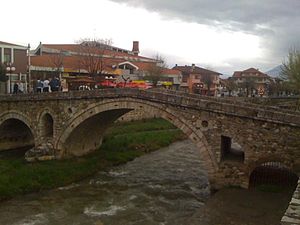 Tannery of Prizren
Tannery of PrizrenThe Tannery/Leatherworks in Prizren (Albanian: Lagjia e Tabakëve, Serbian: Призренска табахана Prizrenska Tabahana[28] )[29] is an ancient handcraft building. Tabakëve is the Albanian, and табахана the Serbian version, both from Turkish: 'tr:Tabakhane', where -ana means house.[30] Gazi Mehmet Pasha HammamThe old Turkish bath (Serbian: Стари хамам Гази Мехмед-паше) is in the center of Prizren. 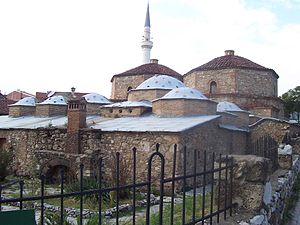 Mosque of Kuklibeu
Mosque of Kuklibeu1534 (1543?) Mosque of Kuklibeu Albanian: Xhamia e Kuklibeut also known as Kukli Bej Mosque Mosque of Mustafe Pasha PrizreniMosque of Mustafe Pashe Prizrenit (Xhamia e Mustafë Pashë Prizrenit/Xhamia e Mustafa Pashës). 1562-1563 Destroyed in 1950 after a storm. It was located at the location of the former UNMIK headquarters, now municipality building 42°12′36″N 20°44′11″E / 42.210060°N 20.736372°E 
1543-1581 Mosque of Muderis Ali Efendi Sinan Pasha MosqueThe Sinan Pasha Mosque (Albanian: Xhamia e Sinan Pashës, Serbian: Синан Пашина Џамија, Turkish: Sinan Paşa Camii) is an Ottoman mosque in the city of Prizren, Kosovo[a] . It was built in 1615 by Sofi Sinan Pasha, bey of Budim.[31] The mosque overlooks the main street of Prizren and is a dominant feature in the town's skyline.[32] 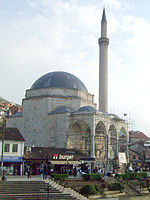 Minaret of Arasta Mosque
Minaret of Arasta MosqueThe remaining minaret of the Arasta Mosque Economy
For a long time the economy of Kosovo was based on retail industry fueled by remittance income coming from a large number of immigrant communities in Western Europe. Private enterprise, mostly small business, is slowly emerging food processing. Private businesses, like elsewhere in Kosovo, predominantly face difficulties because of lack of structural capacity to grow. Education is poor, financial institutions basic, regulatory institutions lack experience. Central and local legislatures do not have an understanding of their role in creating legal environment good for economic growth and instead compete in patriotic rhetoric. Securing capital investment from foreign entities cannot emerge in such an environment. Due to financial hardships, several companies and factories have closed and others are reducing personnel. This general economic downturn contributes directly to the growing rate of unemployment and poverty, making the financial/economic viability in the region more tenuous.[33]
Many restaurants, private retail stores, and service-related businesses operate out of small shops. Larger grocery and department stores have recently opened. In town, there are eight sizeable markets, including three produce markets, one car market, one cattle market, and three personal/hygienic and house wares markets. There is an abundance of kiosks selling small goods. Prizren appears to be teeming with economic prosperity, but appearances are deceiving as the international presence is reduced and repatriation of refugees and internally displaced persons is expected to further strain the local economy. Market saturation, high unemployment, and a reduction of financial remittances from abroad are ominous economic indicators.[33]
There are three agricultural co-operatives in three villages. Most livestock breeding and agricultural production is private, informal, and small-scale. There are five operational banks with branches in Prizren, the Micro Enterprise Bank (MEB), the Raiffeisen Bank, the Nlb Bank, the Teb Bank and the Payment and Banking Authority of Kosovo (BPK).[33]
Demographics
Demographics Year Albanians % Bosniaks % Serb % Turk % Roma % Others % Total 1991 cens. 132,591 75.58 19,423 11.1 10,950 6.24 7,227 4.1 3,96 3 2.3 1,259 0.7 175,413 1998 n/a n/a 38,500 n/a 8,839 n/a 12,250 n/a 4,500 n/a n/a n/a n/a Jan. 2000 181,531 76.9 37,500 15.9 258 0.1 12,250 5.2 4,500 1.9 n/a n/a 236,000 March 2001 181,748 81.9 22,000 9.9 252 0.1 12,250 5.5 5,424 2.4 n/a n/a 221,674 May 2002 182,000 79.6 29,369 12.8 197 0.09 11,965 5.2 4,400 1.9 550 0.25 228,481 Dec. 2002 180,176 81.6 21,266 9.6 221 0.09 14,050 6.4 5,148 2.3 n/a n/a 221,374 Source: For 1991: Census data, Federal Office of Statistics in Serbia (figures to be considered as unreliable). 1998 and 2000 minority figures from UNHCR in Prizren, January 2000. 2000 Kosovo Albanian figure is an unofficial OSCE estimate January–March 2000. 2001 figures come from German KFOR, UNHCR and IOM last update March 2, 2001. May 2002 statistics are joint UN, UNHCR, KFOR, and OSCE approximations. December 2002 figures are based on survey by the Local Community Office. All figures are estimates.
Ref: OSCE .pdf [dead link]According to the 1991 census conducted by the Yugoslav authorities, the municipality of Prizren had a population of 200,584 citizens:
- 157,518 (78.53%) Albanians
- 11,371 (5.67%) Serbs and Montenegrins
- other' [3]
According to the same census, the city of Prizren had 92,303 citizens.
Just before the Kosovo War in 1998, the OSCE estimated the population of the municipality of Prizren:
- Albanians 78%
- Serbs 5%
- others 17%
According to a United Nations estimate in 2003, the city had about 124,000 citizens, most being ethnic Albanians. According to the World Gazetteer, the city only had 131,247 residents in 2010.[1]
Sister cities
Further information: List of twin towns and sister cities in Kosovo Bitola, Macedonia
Bitola, Macedonia Skopje, Macedonia
Skopje, Macedonia Mamuša, Kosovo
Mamuša, Kosovo Durrës, Albania
Durrës, Albania Tirana, Albania
Tirana, Albania Vlorë, Albania
Vlorë, Albania Shkodër, Albania
Shkodër, Albania Istanbul, Turkey
Istanbul, Turkey Zagreb, Croatia
Zagreb, Croatia Osijek, Croatia
Osijek, Croatia
Notable people from Prizren
Main article: List of people from PrizrenSee also
Notes and references
Notes:
a. ^ Kosovo is the subject of a territorial dispute between the Republic of Serbia and the self-proclaimed Republic of Kosovo. The latter declared independence on 17 February 2008, while Serbia claims it as part of its own sovereign territory. Its independence is recognised by 85 UN member states. References:
- ^ a b World Gazzetteer (2010). "Kosovo: largest cities and towns and statistics of their population". http://www.world-gazetteer.com/wg.php?x=&men=gcis&lng=en&des=wg&srt=npan&col=abcdefghinoq&msz=1500&geo=-248. Retrieved 6 August 2010.
- ^ OSCE (September 2009). "Prizren September 2009". http://www.osce.org/documents/html/pdftohtml/1200_en.pdf.html. Retrieved 6 August 2010.[dead link]
- ^ The World Gazetteer
- ^ THERANDA (Prizren) Yugoslavia, The Princeton Encyclopedia of Classical Sites, A Roman town ca. 76 km (47.22 mi) SW of Priština on the Bistrica river in the region of Kosovo and Metohija. It lay on the direct route from Lissos in Macedonia to Naissus in Moesia Superior. The town continued to exist during the 4th to 6th c. but was of far greater significance during the mediaeval period and was even capital of Serbia for a short time during the 14th c.
- ^ http://penelope.uchicago.edu/Thayer/E/Roman/Texts/Procopius/Buildings/4B*.html
- ^ DETELIć, Mirjana: Градови у хришћанској и муслиманској епици, Belgrade, 2004, ISBN 86-7179-039-8.
- ^ http://www.komuna-prizreni.org/repository/docs/PRIZREN-CITY_MUSEUM.pdf[dead link]
- ^ http://muja-live.piczo.com/vilajetetshqiptare?cr=2&linkvar=000044[dead link]
- ^ Bizzi, Marino (1610) Relatione della visita fatta da me, Marino Bizzi, Arcivescovo d'Antivari, nelle parti della Turchia, Antivari, Albania et Servia alla santità di nostro Signore papa Paolo V (Report of Marino Bizzi, Archbishop of Bar (Antivari), on his visit to Turkey, Bar, Albania and Serbia in the year 1610) http://www.albanianhistory.net/texts16-18/AH1610.html "This city contains 8,600 quite large houses,...Prizren is irrigated by fountains and other sources of flowing water,..."
- ^ Bizzi, Marino (1610) Relatione della visita fatta da me, Marino Bizzi, Arcivescovo d'Antivari, nelle parti della Turchia, Antivari, Albania et Servia alla santità di nostro Signore papa Paolo V (Report of Marino Bizzi, Archbishop of Bar (Antivari), on his visit to Turkey, Bar, Albania and Serbia in the year 1610) http://www.albanianhistory.net/texts16-18/AH1610.html "In this region of Serbia they speak the Dalmatian language although the province penetrates partially into Albania, which has its own language."
- ^ a b Leo Freundlich: Albania's Golgotha
- ^ a b c d Archbishop Lazër Mjeda: Report on the Serb Invasion of Kosova and Macedonia
- ^ http://www.trend.infopartisan.net/trd0501/t400501.html
- ^ Human Rights Watch, 2001 Under orders: war crimes in Kosovo, page 339. ISBN 1-56432-264-5
- ^ Human Rights Watch, 2001 Under orders: war crimes in Kosovo, page 338. ISBN 1-56432-264-5
- ^ Andras Riedlmayer, Harvard University Kosovo Cultural Heritage Survey
- ^ The Human Rights Centre, Law Faculty, University of Pristina, 2009 Ending Mass Atrocities: Echoes in Southern Cultures, page 3
- ^ a b c d e f g "Reconstruction Implementation Commission". Site on protection list. http://www.rickosovo.org/inc/eng/home.html. Retrieved 9 December 2010.
- ^ Failure to Protect: Anti-Monority Violence in Kosovo , March 2004. Wuman Right Watch. 2004. pp. 9. http://books.google.com/books?id=zdeulbfSK-YC&pg=PA9&dq=Serbian+prizren+2004&hl=en&ei=uwMBTc_jDcyZOtbQsNoB&sa=X&oi=book_result&ct=result&resnum=1&ved=0CCUQ6AEwAA#v=onepage&q=Serbian%20prizren%202004&f=false.
- ^ Warrander, Gail (2008). Kosovo. Bradt. pp. 191. http://books.google.com/books?id=GCRjKdrmqqEC&pg=PA191&dq=Serbian+prizren+2004&hl=en&ei=ugQBTdbiIs7sObSvzaYB&sa=X&oi=book_result&ct=result&resnum=5&ved=0CDgQ6AEwBA#v=onepage&q=prizren%202004&f=false.
- ^ Diplomatic Observer Official Language
- ^ OSCE Implementation of the Law on the Use of Languages by Kosovo Municipalities
- ^ "Report of Forum #2, Museum of Kosovo". Government of Kosovo, Ministry of Culture, Youth, and Sports. March 5, 2009. http://www.mkrs-ks.org/?page=2,118,204.
- ^ Cultural Heritage Without Borders, Workshop “Integrated conservation"; preservation and urban Planning” in Prizren November 2002
- ^ http://www.setimes.com/cocoon/setimes/xhtml/en_GB/features/setimes/articles/2010/10/25/reportage-01
- ^ http://www.esiweb.org/misc/walkablemappristina/pristina.htm
- ^ http://www.virtualtourist.com/travel/Europe/Republic_of_Serbia/Prizren-720375/Things_To_Do-Prizren-TG-C-2.html just a mention of the legend
- ^ http://www.kosovo.net/kosovo3.html
- ^ http://spomenicikulture.mi.sanu.ac.rs/spomenik.php?id=336
- ^ http://www.archive.org/stream/grammatikderserb00leskuoft/grammatikderserb00leskuoft_djvu.txt -ana aus türk. hane Haus; aufgenommen sind Wörter wie kahve-hane Kaffeehaus, tabehane (tabahana) = tabak-k. Gerberhaus, skr. kaväna, tabakäna;
- ^ Elsie, Robert (2004). Historical dictionary of Kosova. Rowman & Littlefield Publishers, Inc.. p. 145. ISBN 0810853094. http://books.google.com/books?id=Fnbw1wsacSAC&pg=PA145&dq=sinan+pasha+prizren&hl=en&ei=vU1cTIOTEMT58Ab-yNXkAg&sa=X&oi=book_result&ct=book-thumbnail&resnum=4&ved=0CDwQ6wEwAw#v=onepage&q=sinan%20pasha%20prizren&f=false.
- ^ "Cultural Heritage in Kosovo". UNESCO. http://portal.unesco.org/es/files/20059/10826463791Pages_65-77_KOSOVO_report_distilled.pdf/Pages+65-77+KOSOVO_report_distilled.pdf. Retrieved August 6, 2010.
- ^ a b c "BOSNIA AND HERZEGOVINA REPUBLIKA SRPSKA NATIONAL ASSEMBLY ELECTIONS". Office for Democratic Institutions and Human Rights, Organization for Security and Co-operation in Europe. 1997-11-22/23. pp. 32. http://www.osce.org/documents/html/pdftohtml/1200_en.pdf.html. Retrieved 2008-03-27.[dead link]
External links
- Municipality of Prizren by Republic of Kosovo
- Prizren, Serbian capital (Serbian)
- University of Prizren (Albanian)
- Prizren pictures through time (Albanian)
Kosovo Dečani • Đakovica • Dragaš • Glogovac • Gnjilane • Istok • Kačanik • Klina • Kosovo Polje • Kosovska Kamenica • Kosovska Mitrovica • Leposavić • Lipljan • Mališevo • Novo Brdo • Obilić • Orahovac • Peć • Podujevo • Priština • Prizren • Štimlje • Srbica • Štrpce • Suva Reka • Uroševac • Vitina • Vučitrn • Zubin Potok • Zvečan New Municipalities: Đeneral Janković • Gračanica • Junik • Klokot-Vrbovac • Mamuša • Parteš • RanilugPlanned Municipality: North Kosovska Mitrovica
New Municipalities: Đeneral Janković • Gračanica • Junik • Klokot-Vrbovac • Mamuša • Parteš • RanilugPlanned Municipality: North Kosovska MitrovicaHistorical capitals of Serbia 641–950 Destinikon
950–1276 Ras1818–1841 Kragujevac
1849–1860 Temišvar
1914–1915 Kragujevac
1915 Nišsince 1841 BelgradeCategories:- Former capitals of Serbia
- Populated places in Kosovo
- Prizren
- Turkish communities outside Turkey
- Dardania (Balkans)
- Gegëri
- Municipalities of Kosovo
Wikimedia Foundation. 2010.


